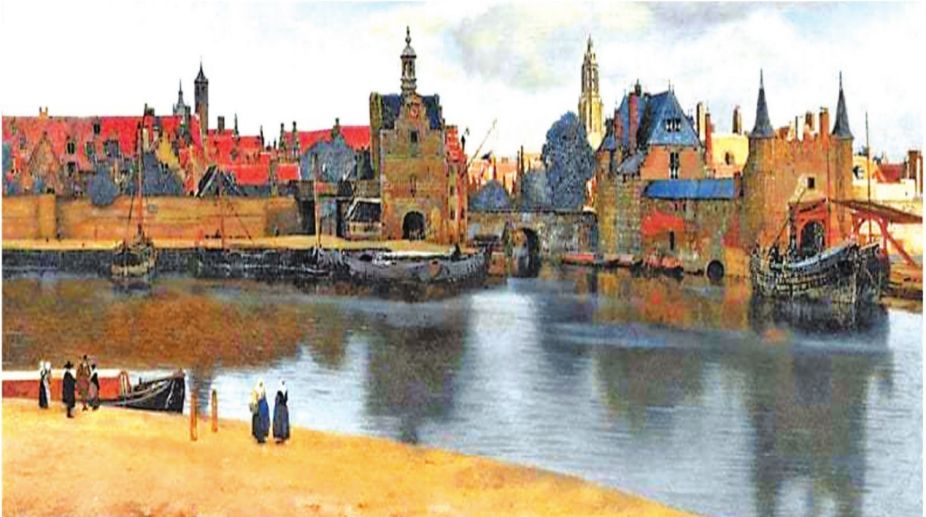Whenever one happens to be in The Hague, what a pleasure it is to visit Delft, a peaceful town full of crisscrossing canals less than half an hour’s bus ride away from The Netherlands’ capital. On a fine, warm day even sipping a cup of tea at a sidewalk café or enjoying a soft drink while watching the boats row by is ecstasy in itself.
However, this little Venice has much, much more to offer to an art enthusiast. Though the Vermeer Museum has nothing of the monumental grandeur of a Louvre, stepping into it is a sensation similar to the one you have when you enter a home to see the works of a painter who invites you in.
Following his rather early death in 1675, Johannes Vermeer’s untraditional creations were practically immediately forgotten in Delft where he was born, where he worked all his life and died. After being ignored for nearly two centuries, about 20 of his masterpieces were discovered in 1866 by French art critic and researcher Théophile Thoré-Burger.
He was astounded to notice the total mastery with which Vermeer captured the rays of light and the illuminated or shadowed angles of flowers, human forms, tables, chairs and other objects in his paintings. The expert’s persistent inquiry inevitably resulted in a thorough hunt by other art enthusiasts of the time. Soon enough, a total of 70 works were listed in a catalogue that Thoré-Burger painstakingly prepared. However, it is generally believed today that no more than 37 of these paintings were actually done by Vermeer, the others being works created under his influence at later dates. This may appear to be a small figure for an artist’s achievements, but when you think of the relatively brief, 43 years of Vermeer’s lifetime, things start falling into place more comprehensively.
Vermeer’s eloquent paintings appear all the more sumptuous when you learn that during his entire career he had no mentor, no students and no friends. He followed nobody’s style and was never able to sell his works while alive. His graceful solitude was perhaps the reason for his being named the ‘Sphinx of Delft’ by Thoré- Burger, a title made popular by other art virtuosos of the period.
Contrary to the accepted tradition when painters could only live and work if they were encouraged and sponsored by royal and aristocratic families, Vermeer preferred to survive in extreme poverty. His characters consequently were fairly often women doing housework, knitting or going through kitchen routines. The backgrounds were inevitably the two rooms of the painter’s own modest house.
Though a few scenes of interiors of other abodes are not non-existent in Vermeer’s paintings, they are rare, and they always represent work — a lady learning to play a piano, a young man trying to paint, a busy astronomer or a geographer studying. Of the 37 so far acknowledged creations of Vermeer, only two paintings show outside vistas of Delft.
The capture of light rays, whether entering a room through a side window or being reflected on people’s faces are so realistic that a number of commentators today claim Vermeer certainly had access to some kind of an elementary version of a photographical instrument, if not really a camera in the modern sense. But serious art critics reject this hypothesis as pure nonsense. ‘Why not accept the simple fact that Vermeer was a genius who had visions of things different from his contemporaries and the mastery to transfer them to his canvases?’ they ask.
The original idea of the organisers at the Louvre museum in Paris was to expose, from February to May this year, the original works by Vermeer in the company of paintings by many other artists who were inspired by the Sphinx of Delft. The exhibition has been a success from Day One — when nearly 10,000 visitors waited their turns to enter the Louvre. The usual number for a successful show on the opening day is normally 5,000.
The organisers finally solved the problem by requesting the visitors to procure advance reservations through the internet in order to avoid extra long waiting times. For the moment, one still has to wait for about half-an hour to enter the hall where the Vermeer’s are being exposed.
Vermeer masterpieces are being exhibited for the first time at Louvre, Paris which is a part of a season dedicated to the Dutch Golden Age Dawn/ANN.











